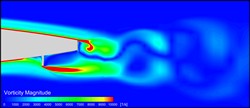One step closer to the smart helicopter
The COMROTAG (Development and testing of computational methods to simulate helicopter rotors with active gurney flap) project was part of the Clean Sky Joint Undertaking. The team focused on active-Gurney-flap systems in helicopter rotor blades. The adaptation of these systems in helicopter rotor is a very challenging task, due to geometrical, kinematic (high frequencies of motion) and strength limitations, specific for the rotor-blade typical conditions. Using computer simulations, the project team examined the configuration of these actuators under different flight cases. ‘During flight simulations, the blade pitch controls were adjusted so as to obtain the desired thrust and moments generated by the rotor. The so-called power loading was used for comparisons of different configurations,’ explains Dr Wienczyslaw Stalewski from Instytut Lotnictwa in Poland, leading the research. Active gurney flaps Among smart blade concepts under development, the active gurney flap has been selected in the framework of the Clean Sky’s green rotorcraft integrated technology demonstrator. This choice was based on its potential impact on helicopter performance and its technology readiness level. Actively deploying gurney flaps in the retreating phase of the rotor-blade motion improves the lift of the rotorcraft as well as its overall performance. This technology is already in an advanced stage of development. However, numerical studies and wind-tunnel testing on rotor blades are necessary for its validation. ‘COMROTAG’s goal was to assess computationally the benefits of active Gurney flaps on rotor blades in real-scale helicopter flights,’ says Dr Stalewski. In addition to taking into account the various aerodynamic forces involved, the project team had to identify combinations of extension levels for the mechanism, air flow direction and speed. ‘Happily, difficulties in reproducing the deep dynamic-stall phenomenon appearing on the retreating blade were overcome, and we also achieved helicopter rotor trimming in this hazardous flight condition. This required significantly more computational effort than dynamic stall-free flight simulations’, he adds. Computational fluid dynamics (CFD) in flight The ‘virtual rotor’ simulation module under development in Instytut Lotnictwa was modified to accurately model blade feathering and flapping as well as the cyclic motion of active gurney flaps. This set of user-defined functions was linked to the commercial CFD software Ansys Fluent, commonly used in aeronautical engineering. ‘The flap motion was reproduced through local deformations of the surrounding computational mesh. The mesh deformation methodology was developed especially for COMROTAG and proved to be a successful alternative to overlapping grid methods,’ notes Dr Stalewski. The simulation results offer valuable input for researchers working on the implementation of active gurney flaps in rotor blades. Tests on helicopters can be planned to obtain flight conditions where the benefits are more pronounced or to avoid dangerous situations for flight safety.’ The new computational methodology is expected to support the development of actuation system solutions that meet both durability and reliability requirements of the aerospace industry. The next generation of smart helicopters will soon be heading to the skies.
Keywords
Smart helicopter, COMROTAG, active gurney flaps, computational fluid dynamics, aerospace industry

